- Home
- Jimmy Guieu
Polarian-Denebian War 2: Operation Aphrodite Page 3
Polarian-Denebian War 2: Operation Aphrodite Read online
Page 3
“Good grief!” Commander Taylor cried out. “When we got here I completely forgot to plant the ‘Earthling’ flag in the lunar ground!”
All the astronauts burst out laughing. Professor Harrington remarked, “Frankly, I’m glad you didn’t plant it when we arrived, Commander. The ceremony would have been pretty pompous and overblown.”
Commander Taylor, a soldier above all else and trying to hold onto his flame of patriotism, shot a dirty look at the physicist, then after thinking about it, he finally smiled, “Hmm… you may be right, professor. I can see the picture now: very ‘cliché.’”
Meanwhile, Lieutenant Clark came leaping in and pulled up at the edge of the crevasse, waving a long, plastic cylinder and calling out to his chief through his microphone, “The flags, Commander… You… We forgot to…”
“Yeah, I know,” the superior officer growled, climbing up the ladder, followed by the other astronauts.
The plastic tube that Lieutenant Clark was holding contained the Stars and Stripes and the flag of the United Nations. Grabbing the tube Commander Taylor panned around the dreary, desolate moonscape. His eyes stopped on the crest of a crater, 100 yards away, with a circular wall almost 200 yards high.
“We’ll plant our ‘standards’ on the top of that crater. They’ll be clearly visible from all around.”
“I’m sure they’ll attract all kinds of tourists.”
“Lieutenant Clark!” Commander Taylor barked into his helmet. “Your jokes on the matter…”
“Come now, come now,” Professor Harrington broke in. “After the extraordinary work we just accomplished, after the most fantastic voyage of all time and the nervous tension we all suffered, don’t you think a little humor will do us good?”
The Commander frowned, sticking his lower lip out, stood speechless for a moment, and then realized the virtue of this sage advice. He finally loosened up. “OK, OK, I’m nervous too and as always, Professor, you’re right. Let’s go play mountain climber!”
He took the lead and bounced lightly, despite looking like a Michelin Man, carrying the long tube holding the emblems of the United Earthlings.
By radio the man on guard in the rocket was called out to participate in the ceremony. Climbing up the slope of the crater was no easy job. The walls had very few footholds and the “moontaineers” often stumbled, almost falling back down the steep wall. Even with their heavy spacesuits and “lightened” by the weak gravity, such a fall would not have been without danger.
After half an hour of slow climbing the ten men reached the summit, 740-foot high as indicated by the special altimeters on the chest of their spacesuits. The crater was somewhere between 5,000 and 5,000 feet in diameter. In the middle was a kind of rocky spike standing almost 600 feet high. Its top looked like a jagged mushroom folding up on itself.
Such craters with central spikes are common on our satellite, but this was the first one that the Earthlings were seeing up close.
Kariven, scanning the inside of the crater through prismatic binoculars, interrupted his examination. He moved his face closer to the transparent cover of his helmet, pressed the binoculars hard against the Plexiglas and refocused.
“No doubt about it,” he spoke into his mic. “I clearly see a bunch of round holes at the base of the crater wall… Look for yourselves.”
Intrigued, the astronauts took out their prismatic binoculars, did as told and in the face of the evidence had to admit that these weird holes, barely a foot in diameter, really were there.
“What do you think it is?” the Commander asked, laying the tube at his feet. He, too, looked through the binoculars and saw the mysterious holes.
“I have no idea. I see at least a hundred of them on the opposite wall and that’s only on the arc running 50 yards beyond the shadow cast by the top of the crater.”
The Commander, in order to see the eastern part of the crater better, stepped to the side without taking his eyes off the binoculars. His right boot kicked the tube, which teetered on the wall before rolling off and bouncing gently down. It took three or four slow bounds and settled at the foot of the rocky slope.
“The flags!” Lieutenant Clark cried out. “The tube fell over the edge!”
The Commander cursed at his clumsiness. Lieutenant Clark and Kariven were already helping each other scramble down the steep wall. Johnny Talbert, the cameraman of the expedition, was filming the two men making their way to the bottom of the crater.
The plastic tube had fallen alongside the wall and rolled into a small ditch in the flat surface of the crater. Obviously there was a slight slope at this spot, tilting toward the wall, because from the top they could see part of the light brown tube.
“Darn!” the cameraman blurted out, putting down his camera and grabbing his prismatic binoculars. “I can’t see the tube anymore…”
Kariven and Clark, hearing this echo in their helmets, stopped for an instant to glance at the base of the crater 50 yards below them. It did indeed seem to them that the tube was not exactly in the same place.
“Maybe it rolled?” the Lieutenant guessed.
“Rolled? After stopping for minutes at the bottom of a slope?” Kariven disagreed. “That would surprise me. We probably didn’t get a good look at its position or else Johnny’s hallucinating.”
“You scientists are funny,” Clark grinned. “If a good guy sees something weird either he’s hallucinating or he’s dreaming!”
“Are you referring to the ‘light’ you think you saw?”
“That I did see,” he corrected.
“That you say you saw?” Kariven corrected in turn.
“Absolutely. I saw a bright, purple beam shoot out of the Aristarchus crater after the rocket flew over the area.”
Starting back down the wall Kariven asked, “And you think it’s normal for a metal tube to change positions all by itself? Come on, pal, you’re believing in ghosts!”
All of a sudden eight shouts of surprise rang inside their helmets.
“But… it’s moving! Good God! The flags are taking off!”
It was Commander Taylor who had just yelled this. Once again Clark and Kariven stopped to examine the basin.
“Billions of blistering booster rockets!” Kariven swore in astronaut jargon.
With their eyes bulging out the two men watched, 30 feet below them, the still visible part of the tube. Slowly, with little jerks, the tube seemed to be sinking into the base of the crater still hidden by a tiny overhanging ledge.
Throwing all caution to the wind and devoured by curiosity, in three bounds they jumped onto the floor of the crater. They barrel-rolled on the ground and stopped after leaving a deep groove in the seleno-cosmic ash. The voices of the astronauts left on top buzzed in their ears in a muddled confusion.
Lieutenant Clark and Kariven took a few steps toward the foot of the crater wall, then suddenly stood still and speechless. On the ground, in the wall of the crater, was a series of holes identical to those they had seen from the summit through the binoculars. And into one of these holes the long plastic tube holding the flags was disappearing!
Kariven jumped and threw himself flat on the ground, grabbing the end of the tube, which was squirming into the dark hole. He finally got up and yanked the tube back, causing it to shoot out of the hole and go rolling to the feet of Lieutenant Clark.
The horrified officer swore out loud and jumped to the side. Stuck to the end of the tube was a brown, throbbing mass!
CHAPTER THREE
Kariven moved closer to Lieutenant Clark and followed his gaze riveted to the ground.
“But… but…,” he stammered, “it’s… it’s ALIVE!”
In rhythmical spasms a weird, brown creature like a kind of flat jellyfish around eight inches in diameter, detached from the tube and slowly went back to the holes. The “thing” moved through the dust by vibrations, making its body ripple in the shape of disc.
“What’s wrong?” Professor Harrington asked.
�
�We… we found an animal… a living being!”
“Living?” Commander Taylor and Streiler echoed together, unbelieving.
“Very alive. This ‘thing’ is moving, crawling toward the holes in the base of the rocky wall.”
“Capture it, by God! Capture it!” the professor screamed. “But don’t kill it whatever you do! I want to study it alive!”
Kariven emptied the contents of a plastic bag containing his rations, maps and a miniature sextant. He hurried over to the “moon beast” and squatted down, blocking its path to capture it. With one knee in the dust he opened the 10-inch wide mouth of the bag.
The creature with a brown shell, twitching forward, stopped 20 inches away from the bag. It spun around slowly and even more slowly moved closer. It stopped exactly at the edge of the of the bag that Kariven kept open, then very cautiously touched the plastic with a kind of greenish fringe that stuck out from the edge of its disc-shaped body. Feeling the plastic material, the fringe tremble a little and then retracted quickly. From the top of the body six little, amber stalks squirmed up and bent forward toward the opening of the bag.
“What are you doing, Kariven?” Harrington asked. “Get it in the bag and come back up!”
“The… the ‘thing’,” he replied, “is busy touching the edge of the bag. Six ringed, flexible stems just came out of its rounded back. They’re stretched out over 12 inches long and are now swaying slowly inside the bag. I have the feeling that they’re eyes or maybe fingers… We’ll have to examine them.”
He stopped talking. The “thing” had just pulled back the six swaying stalks and was cautiously moving backward. With a nimble sweep of his hand Kariven slid the bag along the ground and picked the thing up. He closed the bag, pulled the cord tight and hung it from his belt. The moon beast was caught in the trap.
“Watch out!” Clark suddenly shouted, pointing at the wall.
From every hole a great number of “jellyfish” were pouring out, all headed in their direction. How could such creatures that were apparently so slow be rolling now so quickly, as fast as a man jogging?
The flat beasts were already flowing over the sextant and maps and rations and heading straight for the two Earthlings. More creatures kept coming out of their caves and joining the first ones, forming a moving carpet of brown beasts rippling and pulsating over the ground.
“Quick, Clark! Take the flags and maps. I’ll get the rations and sextant. Kick these things off and kill them but try not to touch them with your gloves.”
“But look, Kariven!” Clark protested. “They’re everywhere. We’ll never get the stuff free and get to the wall without squashing a whole bunch of them.”
“Oh well, but try just the same to move them away with your boots. I don’t think they’ll bite.” He tried to joke.
Digging in the dust with their boots, they kicked away the moon beasts, freed the flag, sextant, maps and rations and then picked it all up, ready to climb up the slope of the crater.
The disc-shaped creatures stopped their weird spasms for a moment. After this brief freeze, as if obeying some kind of signal, they moved as a group and encircled the two astronauts. Thousands of stalks shot out of the carapaces and swayed together toward the space explorers.
Kariven and Clark leaped 15 feet and landed behind the circle of brown creatures. Another leap, this time upward, landed them on an outcrop on the wall. From there they looked back to see the reaction of the mysterious inhabitants of our satellite. They looked surprised and started spinning around, feeling in the dust at the spot trampled by the Earthlings a few seconds before. Finding nothing there the “jellyfish” disbanded and hurried back into their rocky holes.
Professor Harrington, sitting on a metal crate with one elbow on a folding table at the foot of the rocket, was examining the imprisoned “animal” very carefully. It was closed up in a Plexiglas box, 15 inches square, rippling gently. All the astronauts surrounded the physicist, watching the rhythmical movements of the creature.
“It’s absolutely amazing!” babbled Terry Brown, the biologist of the expedition, setting down another crate in front of the table to sit on. “Living beings on the Moon, this dried up star with no atmosphere. Who would’ve believed it?”
Kariven commented, “A number of times astronomers have observed inexplicable changes in the hues and tints in the center of certain lunar craters17. We might think that these astronomers were watching the vast movement of these creatures on the surface of the observed craters.”
“Could be. In fact, it’s very likely,” the young biologist surmised. “But how could life sustain itself in a place lacking water and air and bombarded by the unfiltered rays of the sun? it seems inconceivable… and yet, here we have it before our eyes, irrefutable proof: beings—certainly very rudimentary but living beings just the same—existing on the Moon.”
“It looks kind of like a jellyfish, a dark, drab jellyfish, with a brown shell, almost metallic.”
Using a duralinox rod, Brown turned the beast onto its back. Its underside was a flat disc with a multitude of rippling grooves, the organs of locomotion. In the narrow spaces between the grooves were a countless number of greenish lumps of the same consistency as the vibrating, retractable crown around the rim of the carapace.
“The sextant!” Clark cried out. “Look at the arm of the sextant! What happened to it?”
One whole side of the arc of the blue metal instrument showed pinkish traces like rust or more like corrosion cause by a potent acid.
“Even though it’s plastic the tube holding the flags is also ‘rusted,’” Commander Taylor said.
Kariven rifled through the maps and rations—also contained in plastic—and the bag in which he had carried the “beast”. His face turned into a model of stupefaction. Through the transparent globe of his helmet they could see tiny beads of sweat forming on his forehead.
“Everything that touched these lunar creatures bears traces of intense corrosion! The maps, sextant, rations, the tube were all swarmed over on the floor of the crater by these brown ‘jellyfish’. It was on contact with them that these objects got covered in this pinkish rust. They attacked and even deeper if it was metal.”
“Metallophages!” the biologist’s eyes were round as saucers. “The greenish bumps we saw between the locomotion-grooves must serve as the animals’ mouths.”
Brown grabbed the duralinox rod and for a few minutes stroked the flat underbelly of the jellyfish. The tiny bumps started throbbing. In addition, miniscule, microscopic, pink crystals appeared on the tips of the bumps seen under a very strong magnifying glass.
During the examination the duralinox rod ended up being seriously damaged. A series of pink, jagged spots on its surface formed a layer of “rust,” sinking in, replacing the layer of duralinox absorbed by the metal-eating monster.
“Should we deduce that this being feeds off the energy in the molecules of whatever it touches?” the biologist wondered out loud, pensively. “Is it really an animal or… animal/mineral being?”
With the rod Brown turned the creature back over and absent-mindedly tapped the shell. The six stalk-organs sprang out of their cells and swayed gently. Their tips were covered with a bundle of shiny needles like polished steel, which were constantly vibrating, maybe 0.2 inches long and as thin as a hair.
Still with his rod the biologist tickled one of these stalks with its bundle of seven needles. The shiny points abruptly started vibrating faster, then suddenly retracted. The five other stalks crept forward cautiously, like snakes slithering vertically, and touched the metal rod warily.
Brown pulled back the rod and tapped three times on the brown shell. The stalks spread apart and five of them disappeared into the body of the lunar creature while one remained swaying. He leaned closer and closer to the rod, hesitantly, then brushed over the glimmering metal with its seven needles. After a momentary freeze, it hit the rod three times.
The biologist and the astronauts were stunned. The most surpri
sed of them all, without a doubt, was the biologist. He tried another experiment and gave five taps on the shell. Four stalks came out of their cells and joined the first. They each hit the rod once with their needles. Brown yelped and dropped the rod in the plastic box.
“It thinks! It’s not just an animal but… a thinking being. A Selenite!”
An unpleasant shiver ran down the Earthlings’ spines.
“Don’t get worked up,” Professor Harrington began, whose rational, Cartesian mind did not accept things at face value. “What you think is a response to your tapping, Brown, might be just a kind of unconscious reflex. If you tap a crystal glass, for example, you’ll hear a melodic vibration. But that doesn’t mean that the glass is responding intentionally to your action. I think that we’re seeing a similar phenomenon here.”
“Hold on,” Kariven intervened, pulling out the rod that the creature had crawled over. It was more corroded and had pink scars that were clearer and deeper than before.
Like Brown, he tapped five times on the brown jellyfish. Right away a green stalk sprung out of the shell and hit the duralinox rod five times.
“Uh-um,” Professor Harrington coughed, a little unnerved. “That doesn’t prove that it thinks.”
Kariven started over by striking the captive “animal” two times lightly on its back. The stalk with seven needles swayed a little and then hit the rod five times. A few seconds went by and then the stalk once again hit the rod five times.
Kariven dropped the rod for the creature, which crawled on top of it right away. “Are you convinced?” he asked the professor.
Stupefied, Harrington nodded several times. “Brown was right. This ‘Selenite’ is a thinking being. A simple auto-response would not have answered five times to the two taps, but only twice.”

 Polarian-Denebian War 6: Prisoners of the Past
Polarian-Denebian War 6: Prisoners of the Past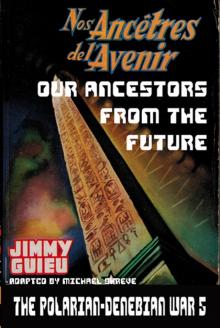 Polarian-Denebian War 5: Our Ancestors From the Future
Polarian-Denebian War 5: Our Ancestors From the Future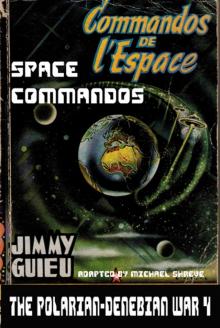 Polarian-Denebian War 4: Space Commandos
Polarian-Denebian War 4: Space Commandos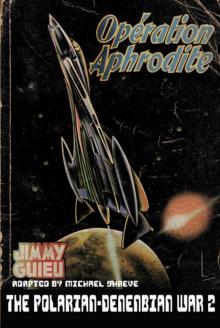 Polarian-Denebian War 2: Operation Aphrodite
Polarian-Denebian War 2: Operation Aphrodite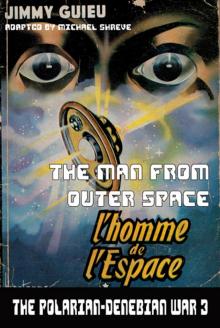 Polarian-Denebian War 3: The Man From Outer Space
Polarian-Denebian War 3: The Man From Outer Space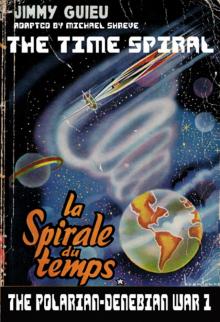 Polarian-Denebian War 1: The Time Spiral
Polarian-Denebian War 1: The Time Spiral